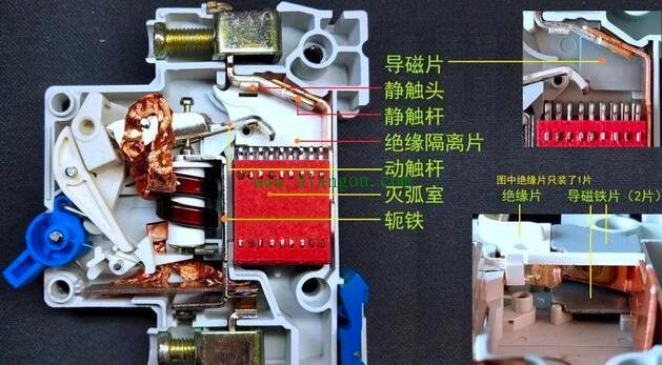Preface
During the grid connection of a newly installed photovoltaic (PV) power station, an abnormal arcing phenomenon was observed in the molded case circuit breaker (MCCB) inside the AC grid-connected cabinet when it was in the open state. Was this caused by the inverter? The answer is clearly no. Based on the on-site photos provided by the customer, it was determined that the MCCB was installed in a reverse feed configuration. After replacing it with a correctly installed model, the issue disappeared.
This article will provide a detailed introduction to the wiring, installation, and selection of common miniature circuit breakers (MCBs) and molded case circuit breakers (MCCBs), explaining why some breakers cannot be reverse-fed.
What is Reverse Feed Connection?
Under normal conditions, the grid power supply is connected to the upper terminals (line side), and the load is connected to the lower terminals (load side)—top-in, bottom-out.
Reverse feed connection means the lower terminals serve as the power input, while the upper terminals serve as the load output.
Since inverters act as the generation side, they are typically wired bottom-in, top-out in circuit breakers. While this may save materials, installation space, and labor, most MCBs do not support reverse feed (bottom-in, top-out). Additionally, most Chinese-made MCCBs also do not support reverse feed.
Therefore, during actual installation, it is necessary to refer to the product manual of the specific model or consult the manufacturer.
Arc Extinguishing Principle
The internal structure of a typical MCB is as follows:
When an overcurrent occurs, the bimetallic strip (composed of two metals with different thermal expansion rates) bends due to heat, triggering the mechanical mechanism to separate the contacts. For short-circuit protection, a large current flows through an internal coil, generating a magnetic field that forces the contacts apart. During normal operation, the mechanical mechanism stores energy in a spring to facilitate tripping.
When the circuit is interrupted, the air is ionized, generating significant heat. MCBs typically use metal arc chutes for arc extinguishing. The magnetic field induced by the chutes creates electromagnetic forces that draw the arc into the chute, splitting it and utilizing the AC zero-crossing point and near-cathode effect to extinguish the arc.
After the current crosses zero, the stationary contact becomes the new cathode, and the remaining positive ions near it block electron emission. This prevents re-ignition for a brief period (~150 microseconds).
Why is Reverse Feed Connection Prohibited? What are the Hazards?
-
Structural Issues:
-
Standard feed (top-in): Power flows through the terminal plate → stationary contact → moving contact → flexible conductor → protection system (bimetallic strip & solenoid) → terminal plate.
-
Reverse feed (bottom-in): Power flows through the terminal plate → protection system → flexible conductor → moving contact → stationary contact → terminal plate.
During interruption, while most of the arc enters the arc chute, some ionized gas moves toward the moving contact. If this gas contacts another phase, it can cause phase-to-phase short circuits. Additionally, in reverse feed, the bimetallic strip, protection system, flexible conductor, and common shaft remain under supply voltage, accelerating insulation aging and increasing the risk of phase-to-phase leakage.
-
-
Higher Transient Recovery Voltage:
-
In reverse feed, due to the presence of components like the solenoid coil, the circuit impedance is higher than in standard feed. This leads to a higher transient recovery voltage (TRV) during interruption, making arc extinguishing more difficult. This can result in dielectric breakdown or arc reignition, causing interruption failure.
-
To address these issues, some manufacturers design breakers with:
-
Larger contact gaps
-
Increased phase-to-phase spacing
-
Enhanced interphase insulation
-
Higher breaking capacity margins
Thus, some joint-venture brands and certain domestic models explicitly state they support reverse feed connection.
Can a Circuit Breaker Be Installed Upside Down (180° Rotation)?
No. PV power station installation standards prohibit this, and the internal structure of the breaker is not designed for inverted installation.
Conclusion
In the AC combiner box of a PV power station, special attention must be paid to the line and load side connections of circuit breakers. Generally, it is recommended to select PV-specific breakers or models explicitly labeled by the manufacturer as supporting reverse feed. Additionally, when reverse feed is used, the rated voltage and breaking current must comply with specifications.
For breakers not explicitly rated for reverse feed, confirmation from the manufacturer is required before installation to ensure 25 years of safe operation for the PV power station.
Post time: Jul-18-2025

